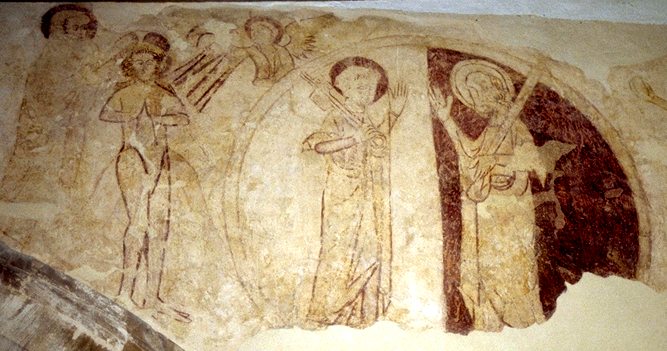Black Bourton, Oxfordshire (†Oxford) Late C.13
The Baptism of Christ and SS Peter & Paul

There are two subjects here, the Baptism of Christ on the left, and Saints Peter and Paul on the right. They are the best preserved of the paintings at Black Bourton and the Baptism is an unusual subject. John the Baptist stands at the left, hands extended above Christ’s head. Christ himself stands frontally, hands together in prayer, against what seems to be a painted hillside rising up behind him to waist level. He has the tripartite halo reserved for Persons of the Trinity, and to the right of him is an angel, perhaps with a censer and what seem to be rays of light coming from Heaven.
Saints Peter & Paul. The two saints are painted in a parti-coloured roundel placed centrally in the space between two arches. Each holds up his right hand in greeting, perhaps of each other, perhaps of us. Each also has his attribute or means of identification, Peter (on the left) his key of Heaven, Paul the sword of his martyrdom. Peter and Paul, who share a feast day on June 29, are often shown together as founders of the church, representing respectively the original Jewish element in Peter, and the Gentile in Paul.
Placed as they are in the central space between two arches, they are given much greater prominence than the Baptism at the left or the Stoning of Stephen (the edge of it just visible on the right).
This may mean nothing at all – although there are a number of paintings (and were probably once more) at Black Bourton, it is impossible to speak of anything like a coherent scheme. There were probably once more Infancy scenes on the opposite side of the nave – a battered Angel appearing to Joseph is still there, close to the Adoration of the Magi. Otherwise the choice of subjects seems haphazard – St Christopher in the expected position almost opposite the South Door, a Tree of Jesse, The Martyrdom of Thomas Becket, and, by the Vestry door, remnants of a painting of him Vesting for Mass, St Richard of Chichester and two Bishops who may also be saints, and the Coronation of the Virgin. But these two paintings raise again the difficult distinction between ‘Devotional’ painting and that of a mainly narrative character.¹ Maybe it is significant that the two (existing) paintings – these two saints and the Coronation of the Virgin – made prominent by their placing within roundels might indeed be thought of as ‘Devotional’ subjects.
We have a Victorian vicar, Canon James Lupton (Vicar, 1827-1873) to thank for the uncovering and preservation of the paintings at Black Bourton in 1866. During his absence in London, however, his curate and a churchwarden covered them with whitewash again. The furious Lupton wrote to Christ Church College, Oxford, owners of the local farm tenanted by the churchwarden, saying that this had been done by ‘my curate and your tenant…contrary to my wishes and express desire’.² Which side Christ Church took in the dispute I do not know, but ironically, we have the iconoclastic curate and churchwarden to thank as well, because the paintings were preserved under their whitewash until EW Tristram found and uncovered them again in 1932.
¹ A distinction briefly discussed in these pages in connection with the ‘Detached’ Crucifixion
² A History of the Church of St Mary the Virgin, Black Bourton, Oxfordshire (booklet in the church) n.d.